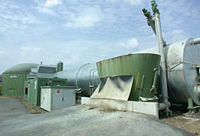
Photo from wikipedia
Background Bioconversion of wood into bioproducts and biofuels is hindered by the recalcitrance of woody raw material to bioprocesses such as enzymatic saccharification. Targeted modification of the chemical composition of… Click to show full abstract
Background Bioconversion of wood into bioproducts and biofuels is hindered by the recalcitrance of woody raw material to bioprocesses such as enzymatic saccharification. Targeted modification of the chemical composition of the feedstock can improve saccharification but this gain is often abrogated by concomitant reduction in tree growth. Results In this study, we report on transgenic hybrid aspen ( Populus tremula × tremuloides ) lines that showed potential to increase biomass production both in the greenhouse and after 5 years of growth in the field. The transgenic lines carried an overexpression construct for Populus tremula × tremuloides vesicle-associated membrane protein (VAMP)-associated protein PttVAP27-17 that was selected from a gene-mining program for novel regulators of wood formation. Analytical-scale enzymatic saccharification without any pretreatment revealed for all greenhouse-grown transgenic lines, compared to the wild type, a 20–44% increase in the glucose yield per dry weight after enzymatic saccharification, even though it was statistically significant only for one line. The glucose yield after enzymatic saccharification with a prior hydrothermal pretreatment step with sulfuric acid was not increased in the greenhouse-grown transgenic trees on a dry-weight basis, but increased by 26–50% when calculated on a whole biomass basis in comparison to the wild-type control. Tendencies to increased glucose yields by up to 24% were present on a whole tree biomass basis after acidic pretreatment and enzymatic saccharification also in the transgenic trees grown for 5 years on the field when compared to the wild-type control. Conclusions The results demonstrate the usefulness of gene-mining programs to identify novel genes with the potential to improve biofuel production in tree biotechnology programs. Furthermore, multi-omic analyses, including transcriptomic, proteomic and metabolomic analyses, performed here provide a toolbox for future studies on the function of VAP27 proteins in plants.
Journal Title: Biotechnology for Biofuels
Year Published: 2021
Link to full text (if available)
Share on Social Media: Sign Up to like & get
recommendations!